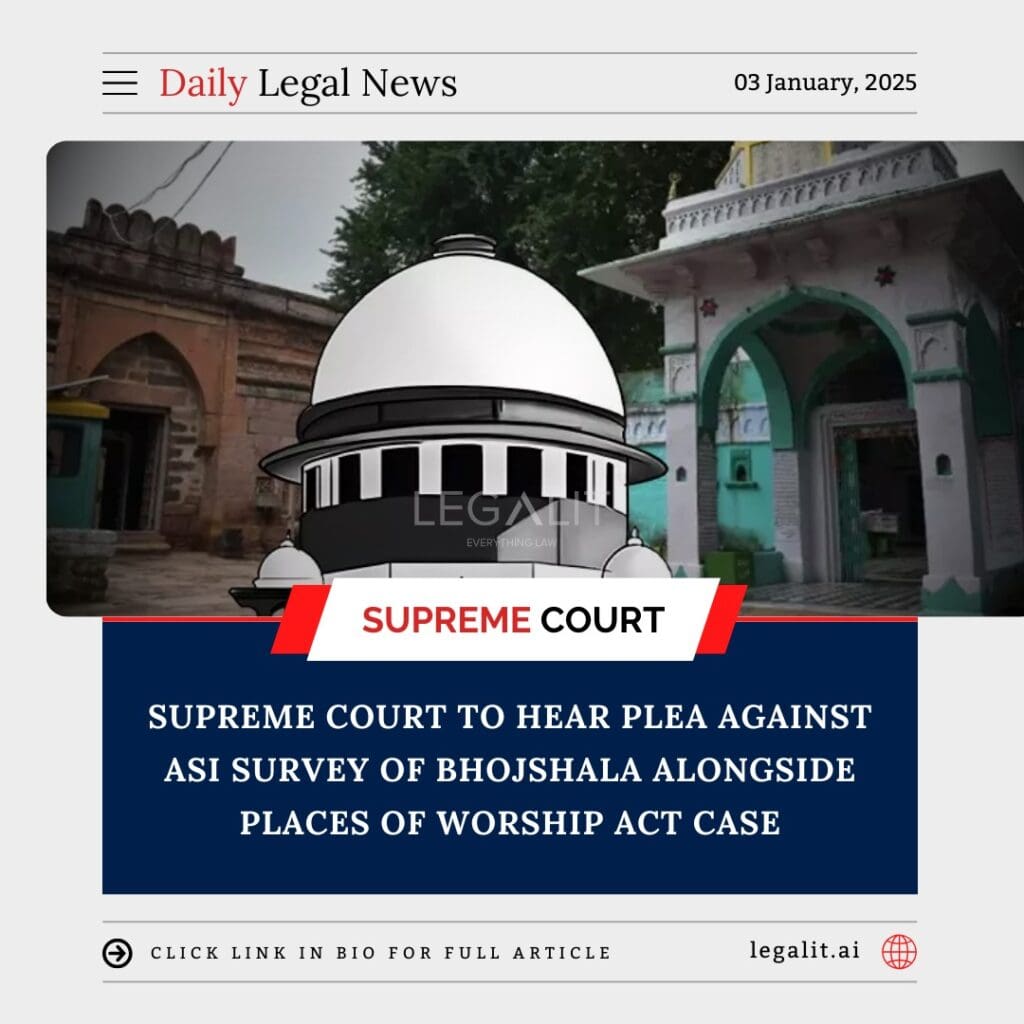
The Supreme Court of India is set to hear a plea challenging the Archaeological Survey of India (ASI) survey at Bhojshala, a site located in Dhar, Madhya Pradesh, alongside the case scrutinizing the constitutional validity of the Places of Worship (Special Provisions) Act, 1991. The decision to club these cases underlines the critical legal and social implications tied to such disputes, as well as the judiciary’s role in navigating them.
1. Historical and Cultural Significance of Bhojshala
Bhojshala holds immense historical and cultural significance, being a centuries-old site intertwined with India’s diverse religious traditions. Hindus recognize it as the Saraswati Mandir, a temple dedicated to the goddess of learning, constructed during the reign of King Bhoj of the Paramara dynasty in the 11th century. Conversely, the Muslim community regards the site as a mosque, citing its use for prayers during Mughal rule.
This duality has turned Bhojshala into a focal point of contestation, with both communities asserting their claims over its religious character. Over the years, it has also become a symbol of broader disputes concerning the ownership and control of religious sites in India.
2. ASI Survey and Its Implications
The ASI began surveying Bhojshala to ascertain its historical and religious character. Such surveys are typically aimed at uncovering archaeological and structural details to document the history of the site. However, the survey has been met with resistance, with critics arguing that it could reignite communal tensions and disrupt the delicate status quo preserved under the Places of Worship Act.
The plea before the Supreme Court seeks to halt the ASI survey, asserting that it contravenes the 1991 Act, which prohibits any alteration in the religious character of a place of worship as it existed on August 15, 1947.
3. The Places of Worship Act, 1991: Purpose and Provisions
The Places of Worship (Special Provisions) Act, 1991, was enacted to protect the secular fabric of the nation by maintaining the status quo of religious sites as of 1947. The Act seeks to prevent communal disharmony and legal disputes over historical claims.
Key provisions of the Act include:
- Prohibition of Conversion: It is unlawful to convert the religious character of any place of worship into a different denomination.
- Preservation of Status Quo: The Act mandates that the character of religious sites remain as they were on August 15, 1947.
- Exception for Ayodhya: The Act explicitly excludes the Ram Janmabhoomi-Babri Masjid dispute, acknowledging its unique and prolonged legal battle.
The ongoing challenge to the constitutional validity of this Act has brought it under judicial scrutiny, with potential ramifications for disputes such as the one involving Bhojshala.
4. Arguments Against the ASI Survey
The petitioners opposing the ASI survey have raised the following concerns:
- Violation of Law: The survey is alleged to breach the Places of Worship Act, undermining its objective to maintain communal harmony.
- Risk of Tensions: Surveys of religiously contested sites could escalate tensions between communities, leading to unrest.
- Judicial Precedent: A ruling in favor of such surveys might encourage similar actions across other disputed sites, potentially opening a floodgate of litigation.
5. Supreme Court’s Role and Considerations
The Supreme Court’s decision to combine the Bhojshala plea with the Places of Worship Act case highlights the interconnected nature of these issues. The court’s deliberations are expected to address:
- Constitutional Safeguards: Balancing the right to archaeological inquiry with the mandate to preserve communal harmony.
- Future Implications: Clarifying the scope of actions permissible under the 1991 Act, which could serve as a benchmark for other similar disputes.
- Legal and Social Balance: Ensuring that justice is served without exacerbating societal divides.
6. Broader Implications for Religious and Historical Disputes
The Bhojshala case is emblematic of the challenges India faces in reconciling its rich, diverse history with its contemporary legal and social frameworks. The Supreme Court’s ruling could either reaffirm the principles enshrined in the Places of Worship Act or pave the way for re-examining India’s approach to resolving historical disputes.
If the court permits the ASI survey, it may set a precedent for similar investigations across the country, potentially leading to the revival of dormant disputes over religious sites. On the other hand, a ruling against the survey could strengthen the Act’s commitment to preserving harmony and the secular ideals of the Constitution.
Conclusion
The Supreme Court’s decision in this matter will not only determine the fate of the Bhojshala survey but also shape the trajectory of how India addresses disputes over religious and historical sites. As the nation awaits this verdict, it underscores the judiciary’s vital role in maintaining a balance between historical inquiry, legal principles, and social unity.